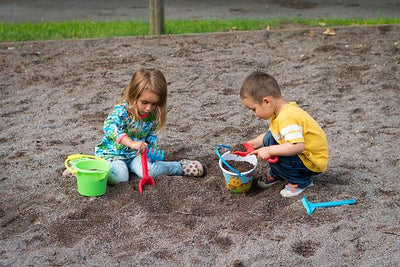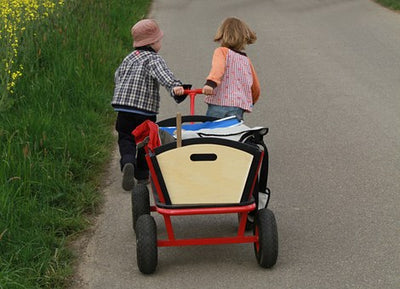By Jeana Kinne, MA and Leia Knight M.Ed
Part 1: Introduction to Language Development
Language plays such an important role in human interactions. How we communicate not only with family members, but our peers, our job and out in the community directly affect our daily lives. Language development in the early years decreases frustration levels, increases the ability to create lasting friendships and directly impacts children’s ways to interact with the world around them.
So how do we help children develop these necessary skills? What is typical and what isn’t? How do I know that my child is engaging with other children in an appropriate way?
Well to first understand how YOU can help your child develop these skills, it is important to understand what the language milestones are. There are two parts of language development.
 The first is Expressive Language: This area of language describes what sounds children are making. It entails first words, gestures to communicate their wants and needs and other forms of communication.
The first is Expressive Language: This area of language describes what sounds children are making. It entails first words, gestures to communicate their wants and needs and other forms of communication.

Ages and Stages of Language Development:
 Infants – Birth through 6 months old
Infants – Birth through 6 months old
In this beginning stage of language development, children are listening to their surrounding environments. They hear everything, respond by looking for noises they have heard and mimic facial expressions made by people who are engaging with them. Babies at this age range use nasal sounds (grunting, cooing, etc) and also start to make open vowel sounds when happy (aaa, oooo).
 Babies - 6 months old through 12 months old
Babies - 6 months old through 12 months old
This next stage of language development is where babies start to imitate new sounds! They look at adults, curious about how their mouths are moving (imitating facial expressions such as sticking out their tongue or smiling) and listen to words that are repeated on a regular basis. You may find your baby babbling “dadada” or “gagaga” on a regular basis. As they get closer to turning one year old, they may start to say “dada” and “mama” meaningfully (using these words to gain a parents attention). They could also have one or two more words such as “ball” and “more”. At this stage, babies are usually able to pick up an object that is VERY familiar to them when they hear it named (such as bottle).
 Toddlers - 12 months through 18 months old
Toddlers - 12 months through 18 months old
This is the age where language play starts to develop! Children start to imitate words they hear on a regular basis (including “more”, “eat”, “all done”, etc). During this stage, you will hear a combination of jargon and words mixed together in a form of a sentence, not always understanding what your child is saying! Toddlers at this stage will use a variety of gestures (such as pointing and grabbing at objects) to get their wants known, since they are hard to understand!
 Toddlers - 18 months through 2 years old
Toddlers - 18 months through 2 years old
This age range is where you see language development explode! Children at this stage continue to add new words to their vocabulary on a regular basis and start to combine two words together (such as “more milk”, “up please” and “thank you”). It usually feels as though once a child starts talking, they NEVER stop! Once your child turns two years old, they start asking a lot of questions, learn more vocabulary and build confidence when communicating with others outside of their immediate family. Children at this stage are able to follow multiple step instructions which create the foundation for more advanced group play.
 Welcome to the Language Explosion phenomenon! As your child’s language skills continue to develop, they start to engage with other children in different ways. Sharing space, toys and people are difficult skills to grasp! Other children don’t always understand the toddler vocabulary and this may cause some behaviors to arise. Although not desired, natural play development includes, grabbing, pushing and pulling in order to communicate with other children. So how do parents support children in advancing their play skills in order to create a safe, happy and enriching learning experience?
Welcome to the Language Explosion phenomenon! As your child’s language skills continue to develop, they start to engage with other children in different ways. Sharing space, toys and people are difficult skills to grasp! Other children don’t always understand the toddler vocabulary and this may cause some behaviors to arise. Although not desired, natural play development includes, grabbing, pushing and pulling in order to communicate with other children. So how do parents support children in advancing their play skills in order to create a safe, happy and enriching learning experience?
The next four emails in this series will describe the four stages of play and how to encourage continued language development through conversations with your child and their peers. If you are interested in learning more about typical language development and milestones which are met at each age range, take a look this link to the American Speech-Language-Hearing Association
About the Authors:
 Jeana Kinne is an Early Childhood Developmental Specialist with a Masters in Education. She currently works with infants and toddlers with special needs and blogs at www.jdeducational.com where she shares tips and tricks regarding child development and answers to commonly asked parenting questions. Jeana created simple and engaging learning activities you can do at home with your children, using items you already have at home. You can find these activities at www.jdeducational.com/collections and follow her on Facebook at JDEducational: Preschool & Kindergarten Readiness.
Jeana Kinne is an Early Childhood Developmental Specialist with a Masters in Education. She currently works with infants and toddlers with special needs and blogs at www.jdeducational.com where she shares tips and tricks regarding child development and answers to commonly asked parenting questions. Jeana created simple and engaging learning activities you can do at home with your children, using items you already have at home. You can find these activities at www.jdeducational.com/collections and follow her on Facebook at JDEducational: Preschool & Kindergarten Readiness.
 Leia Knight is Deaf Educator specialized in Listening and Spoken Language. She developed Language for the Playground to answer the WHY and HOW questions. Why children need social and language skills, why certain skills are important, how to teach these skills, and how these skills affect a child’s functioning in the real-world. Leia discusses strategies, tips and research to answer all your language, listening and social skills questions at languagefortheplayground.com.
Leia Knight is Deaf Educator specialized in Listening and Spoken Language. She developed Language for the Playground to answer the WHY and HOW questions. Why children need social and language skills, why certain skills are important, how to teach these skills, and how these skills affect a child’s functioning in the real-world. Leia discusses strategies, tips and research to answer all your language, listening and social skills questions at languagefortheplayground.com.




